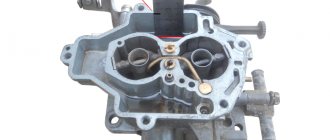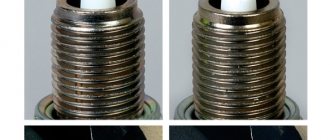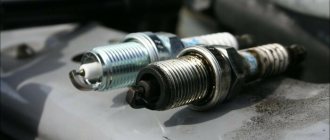What is an internal combustion engine? And how versatile is it? It turns out that starting the engine is complicated by the “cold” temperature regime, which makes it difficult to form high-quality and consistent mixtures, as well as reliable and rapid ignition, the necessary and absolute combustion of the air-fuel mixture. Understanding the principles of engine operation, it is very easy to understand how spark plugs affect gasoline consumption, and whether it is possible to influence this, trying to reduce spending on the family budget.
Internal combustion engine
Let us recall that the working mixture itself consists of fuel, air and exhaust gases that accumulated in the cylinder during the previous operating cycle. Gasoline engines have a special source of necessary heat, without which it is simply impossible to imagine the combustion of the working mixture in the cylinders and the desired start of the vehicle. This source is the spark plug spark.
Features of the functioning of the ignition system
The ignition system is part of the vehicle's electrical equipment and directly affects the functioning of the vehicle. It must ensure the appearance of an electric spark, which at the right moment ignites the mixture of fuel and air entering the cylinders of the internal combustion engine. Failure of a part of this system will significantly change the operation of the mechanism.
Spark plugs provide an electrical discharge between the electrodes. The spark must appear in time so that fuel is not wasted. Any malfunction will affect the operation of the car. A change in the amount of gasoline consumed, the engine tripping, the appearance of strange sounds, odors, vibrations are reasons to check the condition of the device.
Ignition timing is the main parameter that demonstrates the operation of the system. The indicator characterizes the time required for a spark to ignite the compressed working mixture. If the car mechanism malfunctions, the ignition becomes late or early. Both phenomena lead to a decrease in engine power, efficiency, and efficiency. Excessive heating and increased load on engine parts are also observed.
Speed is the enemy of your money
You've probably already heard about this: the higher the speed of the car, the higher the fuel consumption. What about the real numbers? Aerodynamic drag, which leads to increased fuel consumption, is not so noticeable in urban driving conditions. The highest fuel consumption begins at speeds above 90 km/h. Increasing speed from 90 to 105 km/h, aerodynamic air resistance increases by 36 percent! If you often drive on the highway and try to get to your destination faster at maximum speed, then your fuel costs may increase by 17,500 - 21,500 rubles per year. Stick to a speed of 80-90 km/h and, if possible, use cruise control on the highway. It will pay off.
Vehicle fuel consumption when driving
The indicator is equal to the amount of fuel mixture spent, reduced to the distance traveled or in 1 hour. The volume of gasoline consumed is one of the most important characteristics of a car, changing under the influence of many elements of modern designs.
Fuel consumption depends on the following:
- fuel quality;
- vehicle operating conditions;
- driving style;
- engine efficiency;
- aerodynamics;
- weight of the mechanism;
- power consumption of additional equipment;
- system malfunction;
- timely appearance of a spark when fuel arrives;
- tire resistance.
How do spark plugs affect fuel consumption?
Suitable for the vehicle, timely replaced devices ensure a stable spark and efficient ignition of the combustible mixture. If even one fails, starting the engine will be difficult, there will be misfires, floating speed when idling, a decrease in dynamics when starting to move, or picking up speed. The gap in the spark plugs directly affects the performance of the car. You need to select according to the recommended values corresponding to the make of the car. Typically standard values are in the range of 0.5-0.9 mm.
The main problems with spark plugs are caused by the wrong choice for a particular car, or exceeding the service life recommended by the manufacturer. The latter is indicated with a small margin - the spark plug will continue to function for some time, but continued use will lead to deterioration in engine performance, excessive fuel consumption, and increased load on other parts.
Sometimes a car has problems in other systems, and the spark plugs suffer as a result of these violations. For this reason, it is necessary to pay attention to the condition of the parts until the end of the recommended service life. Replacement may be needed a little earlier. The main symptom in the absence of interruptions in operation is a change in the amount of fuel consumption.
The influence of the correct clearance on engine performance
The gap is a really important parameter. It can either be big or too small.
Small gap
If small values are set between the electrodes, then misfires will occur in the ignition system. The thing is that the spark that forms between the electrodes, which are as close to each other as possible, is not enough to ignite the fuel mixture. The spark, although strong, is not sufficient. This is why many cars will really jerk when driving and not develop enough speed. The carburetors may have flooded spark plugs, which will only cause problems – it will generally cause problems. The gap needs to be increased!
How much is a small gap? If we talk about size, it is approximately from 0.1 to 0.4 mm. We definitely check the candles after purchase, I’ll give practical recommendations below, but for now let’s talk about long distances.
Big gap
You know, many manufacturers set the normal distance between the electrodes in advance. But over time, it can increase on its own.
It's all about spark plug wear, which manifests itself with high mileage - this is natural. After all, the electrodes are made of metal, which, under the influence of temperature and constant electrical discharges, begins to slowly burn out. Both the upper one, which resembles the letter “G”, and the lower one suffer. The top one becomes thin, instead of a rectangular shape, it begins to be rounded, because the sides burn out. The bottom one just sags down.
Due to this distance, the spark that passes between the contacts weakens. And significantly! It may also not be enough to ignite the fuel.
Often, because of this, the insulator of the lower contact is pierced; the whole point is that the spark tries to find the shortest path between the electrodes.
In winter, there is a high probability that the car simply will not start.
Another important aspect is that deposits in the form of soot may more often appear on distant electrodes; the spark “suffers” from the long distance, and so does deposits! It may not pass at all. Therefore, it is important after a certain mileage, with our fuel it can be already 15,000 km, to unscrew the spark plugs if necessary, change them, or clean them.
Large distance - from 1.3 mm and above.
Excessive fuel consumption and faulty spark plugs
Any changes in the operation of the car or the appearance of individual parts are a reason to think about the root cause. Faulty spark plugs negatively affect gas mileage. What can be judged by the condition of the device:
- engine trouble, the car does not start - the reason is the failure of one or all spark plugs;
- black coating, darkening of the ceramic part of the part - malfunction of the injector, power unit, low quality fuel;
- uneven coating indicates the wrong choice of device for a given car;
- additives in gasoline and oil cause the appearance of tar-coke and varnish deposits;
- electrode burnout - incorrectly set ignition;
- premature wear of the electrode - low quality fuel or oil, overheating, engine detonation;
- Dry spark plugs are observed when the fuel pump motor fails, pipelines are clogged, injectors are faulty, or the coarse filter is dirty.
The appearance of soot and dark plaque
A much more common malfunction is black spark plugs, which is associated with darkening of the ceramic coating by combustion and fuel processing products. This can be caused by any change in the operation of the power unit, a faulty injector or low-quality fuel. Quite often, only one spark plug from the entire row darkens, and the reason for this may be in it itself, and not necessarily in the operation of the elements of the piston group. This may be due to the wire or tip not working.
The deposit may be applied unevenly, which indicates that the spark plug does not match the specific markings of the car engine. For example, if the heat value is higher than the permissible value, then the top of the candle will turn black, while its body will retain a snow-white hue. Their darkening can also be affected by ignition that is too late. In the case of a faulty injector, a similar effect also occurs, which is associated with the working mixture being too rich. Thus, if after replacing the spark plugs, check how well they match the engine of your car.
As you can see, any problem can and should be diagnosed. The sooner this is done, the sooner it will be possible to understand why the car began to “eat” more gasoline or diesel fuel, and whether the spark plugs are to blame. See you in new publications and articles! Have a good day!
The better spark plugs made of iridium and platinum
Often, consumables are made from alloys of nickel, chromium, copper, iridium, platinum, which directly affects the functioning, cost, and service life of spark plugs. It is not justified to install expensive parts on outdated car models, so when choosing a specific product you need to focus on the vehicle.
Benefits of platinum:
- protection of the central electrode from corrosion and high temperatures;
- service life up to 50,000 km;
- fuel economy, full engine performance;
- strong, stable spark;
- The central electrode is thin and strong.
Iridium is more expensive, but has the following advantages:
- designed for a mileage of 100,000 kilometers;
- stability of spark formation is ensured by a thinner electrode than that of platinum spark plugs;
- increased wear resistance;
- withstand high temperatures.
Advice for car enthusiasts on fuel consumption
Following simple recommendations will help you avoid excessive consumption of fuel and keep your vehicle's systems and spare parts in good condition for a long time. Basic tips:
- A variety suitable for the car, timely replacement of spark plugs.
- Purchasing high-quality fuel that matches the vehicle brand.
- Changing your driving style to a smoother, more gentle one.
- Avoiding frequent, prolonged travel at low speeds, such as traffic jams.
- The appearance of soot and damage is a reason for premature replacement of the device.
- Timely maintenance is the best preventive measure.
Conventional spark plugs require replacement after 30,000-50,000 km, improved spark plugs - 90,000 km. Sometimes the procedure needs to be performed earlier than the time specified in the instructions. The main prerequisites are excessive fuel consumption, problems with engine operation, and changes in the appearance of the spark plugs. When the device is worn out, skips occur, reducing the performance of the motor, leading to an increase in the load of other parts and systems of the machine
Setup recommendations
Checking and adjusting the gap on the spark plugs of the ignition system is carried out in the following situations:
- After repairing the engine, power supply and ignition systems, or before measuring compression in the cylinders. During operation, the spark plug electrodes gradually burn out and become thinner, causing the gap between them to increase.
- When replacing spark plugs with new ones. Often the manufacturer sets the gaps too small, which have to be increased to normal.
- When the engine became unstable. The first step is to unscrew the spark plugs, thoroughly clean the contacts, adjust the interelectrode distances and check their performance under pressure.
Cleaning the electrodes and pads from carbon deposits should always precede adjustment.
An important point to remember is that it is impossible to clearly set the gap on the spark plugs without a feeler gauge. Adjusting by eye will do as a temporary measure until you get to the garage with the tool.
- Remove the spark plugs from the engine cylinders and allow them to cool to room temperature. It is impossible to measure the size of the gaps “hot”.
- Clean the contacts with a wire brush and check the gap between the electrodes with a probe of the required thickness. The latter should fit tightly between the contacts, with little resistance.
- If the feeler gauge does not fit, increase the gap by bending the top electrode with a flat-head screwdriver. Too large a distance can be removed by gently tapping the contact.
It is easier to perform the operation on a cooled engine - you won’t have to burn your hands while unscrewing. For regular spark plugs, use a flat probe, and for products with 2-3-4 side electrodes, use a round tool. Install the spark plugs in the cylinders, start the engine and observe the idle speed. If the previously noticed vibration does not stop, the fault should be looked for elsewhere.
Owning a car means regularly replacing many parts. One of these parts are spark plugs, which are responsible for the timely ignition of the air-gasoline mixture. Their performance is assessed by analyzing the gap between the electrodes. It can vary depending on many factors. Therefore, if problems arise in the operation of the engine, the spark plugs are first checked. In this case, the gap between the electrodes is assessed. Then you can ask the question - what should be the gap on the spark plugs so that there are no problems in a running car.










